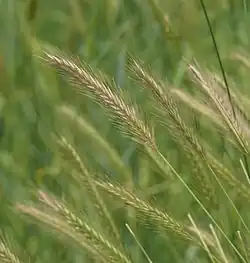Hordeum secalinum
| Hordeum secalinum | |
|---|---|

| |
| Scientific classification | |
| Kingdom: | Plantae |
| Clade: | Tracheophytes |
| Clade: | Angiosperms |
| Clade: | Monocots |
| Clade: | Commelinids |
| Order: | Poales |
| Family: | Poaceae |
| Subfamily: | Pooideae |
| Tribe: | Triticeae |
| Genus: | Hordeum |
| Species: | H. secalinum
|
| Binomial name | |
| Hordeum secalinum | |
| Synonyms[3] | |
|
List
| |
Hordeum secalinum, false rye barley or meadow barley[1] (a name it shares with Hordeum brachyantherum), is a species of wild barley native to Europe, including the Madeiras, Crimea and the north Caucasus, northwest Africa, and the Levant.[3] It has been introduced to Australia and New Zealand. An allotetraploid, it arose from ancestors with the Xa and I Hordeum genomes.[4]
References
- ^ a b Rhodes, L.; Bradley, I. & Maxted, N. (2016). "Hordeum secalinum". IUCN Red List of Threatened Species. 2016: e.T172091A19409324. Retrieved 10 December 2023.
- ^ Spic. Fl. Lips.: 148 (1771)
- ^ a b "Hordeum secalinum Schreb". Plants of the World Online. Board of Trustees of the Royal Botanic Gardens, Kew. 2017. Retrieved 26 August 2020.
- ^ Cuadrado, Ángeles; De Bustos, Alfredo; Jouve, Nicolás (2017). "On the allopolyploid origin and genome structure of the closely related species Hordeum secalinum and Hordeum capense inferred by molecular karyotyping". Annals of Botany. 120 (2): 245–255. doi:10.1093/aob/mcw270. PMC 5737408. PMID 28137705.
